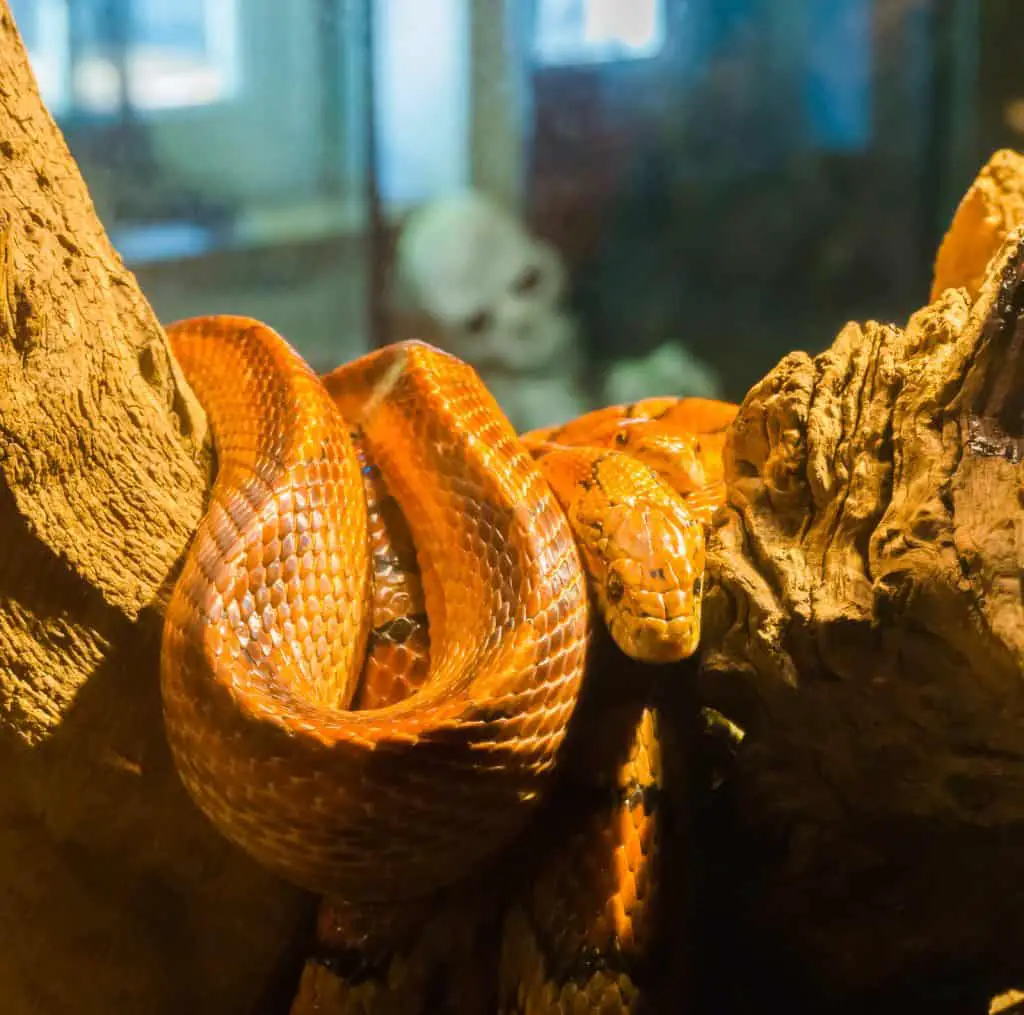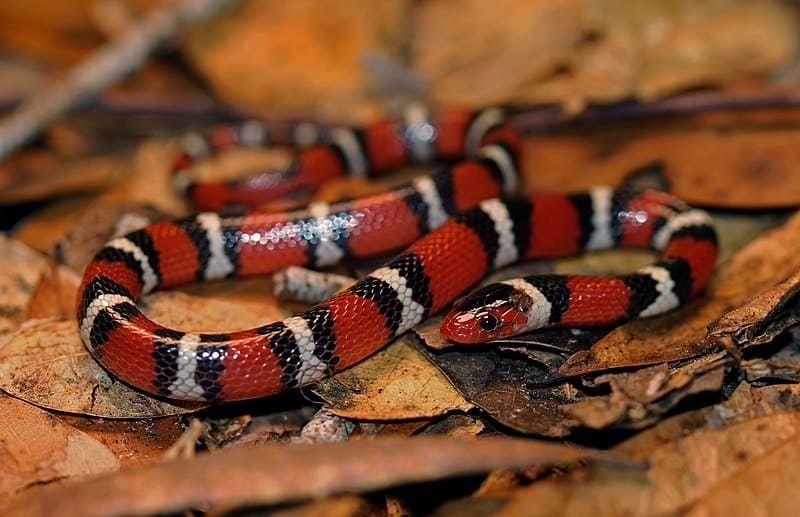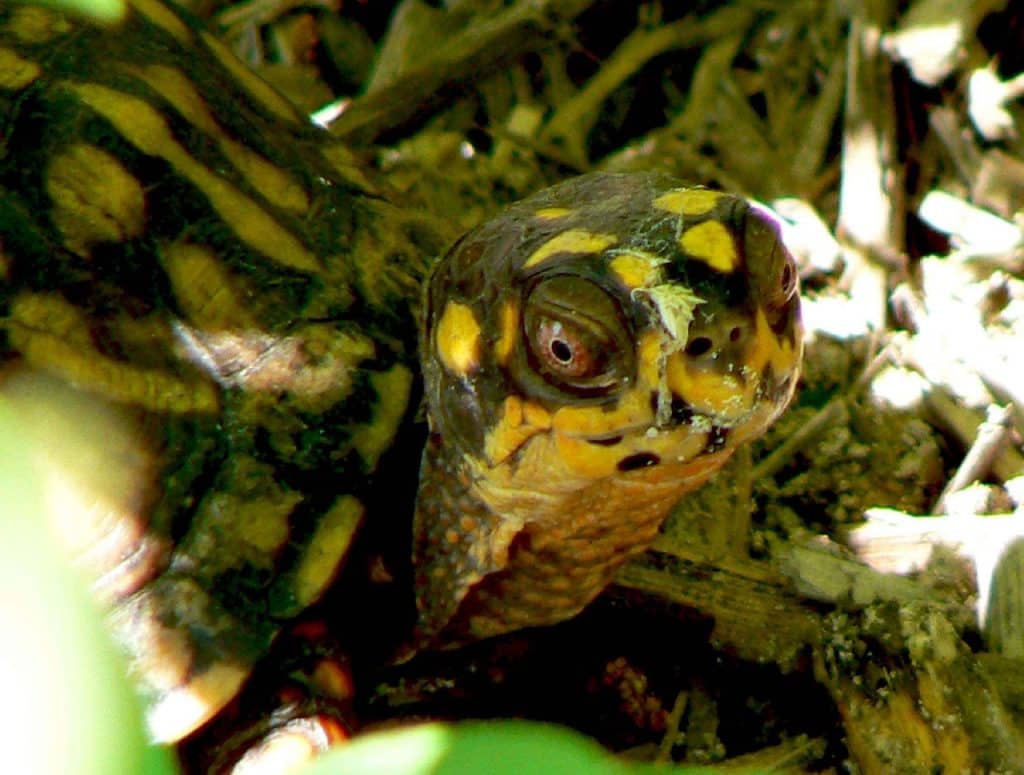If you’re ever in Florida and you see a rat snake, don’t be alarmed! Most rat snakes in Florida (or anywhere I assume), are actually very docile and mostly eat rodents. In fact, they’re so good at catching rats that some people call them rat snakes.
They’re also known for being incredibly long – some of them can grow up to seven feet long! So if you see one slithering through the grass, don’t worry – it’s just doing what it does best.
The average length of an adult eastern ratsnake is 42-72 inches (106-183 cm), with a record length of 101 inches (256.5 cm).
Coloration varies, but youngsters have a gray body with black spots and a sandy-gray belly with dark square patches.
Juveniles and adults appear similar in the Panhandle. On the other hand, adults in the Florida peninsula may be yellow, orange, brown, or gray with four dark longitudinal stripes, with the black dorsal patches seen in juveniles.
The tongue is primarily black. There are 25-27 dorsal scale rows at midbody, and the scales are faintly keeled. The pupil is elongated.
Only six of Florida’s 45 snake species are poisonous. Some of the others may bite you, but a few stitches and a tetanus injection should be enough to get you back on your feet.
The majority of Florida snakes are harmless and helpful in that they help to control rodent populations.
Even poisonous species aren’t very hazardous unless they’re stomped on or disturbed in some other way.
The following are poisonous snakes:
1. Eastern coral snake
2. Southern copperhead
3. Cottonmouth
4. Eastern diamondback rattlesnake
5. Timber rattlesnake
6. Dusky pygmy rattlesnake
Don’t you feel much better now?
Most snakes feel frightened when they see you and slither away as quickly as they can.
If they can’t get away from you, they will try all sorts of strange things to defend themselves.
1. Indigo Snake
2. Indigo Snake
3. 12Save
They bite because they don’t have claws with which to scratch you.
SNAKES IN FLORIDA CAN CLIMB TREES.
Some snakes, such as the corn and green snakes, are excellent climbers and prefer to dwell in trees and bushes.
Others, such as the indigo snake, coachwhip snake, and king snake, are ground dwellers.
Others, such as the brown and ring-necked snakes, burrow in the dirt and leaf litter.
Water snakes and rainbow snakes, for example, are aquatic snakes.
Snake habitats include pine Flatwoods, hardwood hammocks, cypress ponds, wet prairies, Florida scrub, marshes, swamps, ponds, and lakes.
Burmese Python

Although the Burmese Python is not a native of Florida, it has become a severe issue, particularly in the Everglades.
The majority of the 100,000 or more pythons slithering about Florida are said to be descended from pets released into the wild by owners who were fed up with them.
These pythons may reach a length of 20 feet and devour whatever they can grasp with their fangs and constrict to death. Deer, tiny animals, birds, and even alligators fall into this category.
Wherever they become an invasive species, these snakes devastate the natural equilibrium.
Under certain circumstances, the Florida Fish and Wildlife Conservation Commission permits persons to catch and remove pythons. They promote it.
Without a hunting license, the snakes may be killed humanely at any time of year. Humanely implies putting a captive bolt or pistol precisely on the snake’s head and killing it instantly.
Range in Florida
Eastern rat snakes may be found in Florida’s Panhandle east of the Apalachicola River and down the peninsula to Key Largo. In the Panhandle, however, they readily interbreed with gray rat snakes (Pantherophis slides).
I WAS BIT BY A FLORIDA SNAKE ONCE.
I’ve only ever been bitten by a Florida snake once, when I was a student at the University of Florida in Gainesville, and inadvertently trapped one in the toilet of a hut I was staying in. It was a three-foot-long black snake that bit me on the side of my hand.
I didn’t see the bite coming since it occurred so quickly. At the exact moment that I spotted the snake, it saw me. It was coiled next to the toilet in the bathroom’s corner.
As I reached down to raise the toilet seat, he sprang up and bit my hand. quietly exited the restroom and shut the door behind me (remembering that being cool is crucial!). I walked next door and asked my Florida Cracker next-door neighbor to look at it.
It was a non-venomous black racer, which he killed with a machete. I was skeptical, but I needed a second opinion, so I went to the hospital emergency department with the snake in a plastic bag.
After a doctor assured me it wasn’t poisonous, I went home and gave me a tetanus shot, antibiotics, and a band-aid.
If that’s how he came in, I sealed the opening around the bathroom plumbing so no additional snakes could get in.
Are Florida rat snakes poisonous?
They are not poisonous. Eastern rat snakes aren’t harmful to humans or pets, but they’ll bite if they feel threatened. These snakes aren’t aggressive, and they stay away from humans and pets. Almost all snake bites occur when the snakes are deliberately harassed.
Defensive behavior
Eastern rat snakes may run for cover or stay motionless to escape discovery if approached. If cornered, both adolescents and adults will strike at the assailant while quickly vibrating the tip of their tail, which makes a buzzing sound in leaf litter. They may bite the aggressor if seized or pinned. When handled, however, these snakes usually quiet down quickly. Despite this, these snakes are not aggressive, and striking is only employed as a last option in defense.
How do you identify a rat snake?
Racers’ bodies are covered with elliptical, consistent spots that run the length of their bodies. Rat snakes have unevenly formed (but uniformly shaped) spots running along with their bodies. In contrast to the rattlesnake’s “velvet tail,” both patterns go down the tip of their pointed tails. There isn’t even a sliver of a stripe on the back!
Can a rat snake hurt you?
If a Rat Snake bites you, the bites may be very painful, but they are just punctures and are entirely harmless. Visit a hospital right away. They may treat it as though it were an ordinary wound.
What do Florida rat snakes eat?
The rat snake’s food consists mainly of small animals (such as rodents), reptiles, birds, and bird eggs. Because they lack venom or fangs, this species kills their victim via constriction.
How do I get rid of rat snakes?
Sweep the snake into a big bucket, ideally one with a capacity of more than 5 gallons, using a broom or rake. Remove the rat snake from the den and release it outdoors. To prevent rat snakes from returning, eliminate all food sources. Food spills should be cleaned up, and tall grass, leaf heaps, and stone piles should be removed.
What happens if a rat snake bites you?
The majority of snake bites result in pain and edema around the bite site. Fever, headache, convulsions, and numbness are among symptoms of poisonous snakes. However, similar symptoms may also develop as a result of the bite’s acute anxiety. Bites may trigger an allergic response, including anaphylaxis, in some individuals.
Wrapping Up…
They may not be the prettiest reptiles in the Sunshine State, but Rat Snakes sure know how to pack a punch when it comes to flavor!
These slithering carnivores typically dine on small mammals, but their diet can also include frogs, lizards, and birds.
While they may not be as common as other snakes in Florida, Rat Snakes can be found throughout the Florida peninsula!







